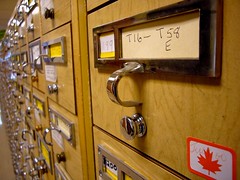I have been pretty excited to see libraries talking about and looking into adapting BISAC to use with non-fiction classification. My buddy Ken Hall over at Fond du Lac Public Library is putting this into play at his library (and has a nice explanation here). What calls to me about this system is that it still maintains subject organization but also invites the art of browsing to sing out as well.
Many, many years ago, at my former job, my visionary director Jack Fry and I concocted a heretical new Dewey/Cuttering system that vastly simplified our kids NF collection and was easy to use. Although not quite as simple as the bookstore's BISAC, it incorporated the concept that kids are not necessarily looking for a specific book by a specific author in a subject section but rather books in general about the subject they are interested in.
I had watched for years as kids, parents and A+ student shelvers struggled to find and get the books they were looking for. And as a borderline dyslexic, I had my own nightmares with transposed numbers in the great forest of Dewey's decimals.
So we tried to use no decimals at all or at very most, when push came to shove, one number beyond the decimal. Rather than using the cutter to designate the author's last name, in sections where the decimals had been decimated (bwa-ha-ha-ha), we used a generic letter to separate types of books in a subject. That reads like Greek to me so let me give a couple of examples.
Baseball's Dewey Decimal (DD) number is 796.357; football is 796.332; basketball is 796.323. So we designated sports books as 796.3 and put all baseball books as 796.3 B (B=baseball); football books as 796.3 F (F=football); all basketball books as 796.3 C (C= "court" sports); soccer as 796.3 S, etc. We chose not to include an author's name in the spine label, just subject of the book. These collections were totally browse-worthy.
Same in mammal books in the notorious 599.7, 599.6, 599.3 sections. Bears would be 599.7 B, big cats 599.7 F (feline), and onward. We kept the same basic Dewey number but just gathered all books on bears into one designated number/letter and let the kids browse. We chose this formula in any section of the collection that had great long Dewey strings (crafts and animals spring to mind...we were never ever brave enough to tackle 398's. I'm afraid..they defeated me). We didn't assign the collection letter willy-nilly - we chose letters that matched the DD designation. We just truncated it and translated it to be user-friendly.
Kids loved it, parents loved it, shelvers worshipped at our feet. I always hoped this would catch on somewhere but catalogers were universally horrified and condemnatory and they control how we present stuff to our public (unless you were lucky like me to have a visionary director who said go for it and control of the cataloging...yes, I was cataloger AND children's librarian!). I always thought it was a shame. It made me think about whether we listen hard enough in libraries to the folks who work with kids and know gobs more than people think we do (but that's another whole 800 posts worth!)
As to whether kids can handle more complex DD numbering in later years if not exposed or taught DD early? I have a hunch they can. Someone did a study years ago saying that the average reading level of a catalog was 6th grade and I figure decimals as an everyday skill is out there in upper elementary grades as it is..a time when kids are aging out into the wild blue yonder of the adult collection for their research. It's a bit like not teaching geometry until our minds can handle that level of mathematical visualization. It's not for most 4th graders.
It has always struck me as trez bizarre that while we want to organize the info for ease of use, we continue to make it very difficult for the average Joe and Jill to find the darn stuff. I am thrillingly happy that brave souls in libraries are finally seeing BISAC as the way to a future that honors organization but does it in a language that the general public is familiar with (although I must admit I do love making the analogy with kids on class visits that Dewey is just MY world language rather than Spanish or Japanese or German!).
I am all for making libraries easy to use so that we can follow one of my most favorite of Ranganathan's Rules: "Save the time of the reader"!
Image: '09-may-20' http://www.flickr.com/photos/91255327@N00/3565110921
Subscribe to:
Post Comments (Atom)


I'm really looking forward to touring Fond du Lac once bisac has been implemented. After giving my "dewey talk" for class visits for two years (and six times in the last week and a half) I've decided there's no reason for us to have Dewey for such a small children's nonfiction section! I've added magnetic subject labels to the shelves and I'm hoping to kill Dewey at some point in the future, at least in the children's area. Oh, and I started life as a librarian as a cataloger. Cataloging is supposed to be about making materials accessible!
ReplyDeleteI too am very interesting in learning more about BISAC at WLA convention. I have made some fiction changes in my library to make us more user friendly. I was wondering, Marge, how you grouped the animals, if they started with the same letter, after the Dewey call number.... say - D for deer and D for dogs? If you go with C for canine, then what happens to the C for Cats? Do we as librarians need to be using the same format from library to library? User friendly, but not confusing! Shirley, Viroqua, WI
ReplyDeleteI LOVE the simplified Dewey in the Children's Room. It's amazing! Little ones still give me strange looks with the simpler system, but I look at it as a teaching moment. I look forward to hearing more about BISAC and the glades/neighborhood shelving systems. The times are a changin'. Happy shelving, everyone!
ReplyDeleteShirley,we actually followed the Sears/DDC headings pretty carefully. So we would look at assign a cutter letter within the Dewey number that always worked for the genus/species type: deer are in the cervidae family and they became 599.6 C for all members of cervidae that we cataloged. Pigs are suiforms and became 599.6 S; canines (including wolves) became 599.7 W. I would love to see some consistency across the boards but this was just a little homemade system that we couldn't even convince libraries in our system to adapt. Just to radical and not LC approved I guess ;->
ReplyDeleteI chuckled at your comment about the 398s. A previous head of dept. came up with a solution. The books are 398.2, but with the geographical origin designated: first by continent (roughly) and then country. So, Denmark would be 398.2 Euro 170; England would be 398.2 Euro 111. China would be 398.2 Asia 110, Japan would be 398.2 Asia 160. You get the idea. Yes, it's a bit cumbersome, but all variations of Little Mermaid are together. It has gotten a bit messy to shelve as there has been no consistency as to authorship - some will be Anderson, some will be the "new" author. The patrons seem to like having like items together, once it gets explained. No one remembers the country numbers, but it doesn't matter once you start looking, it's clear by the titles.
ReplyDelete